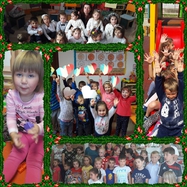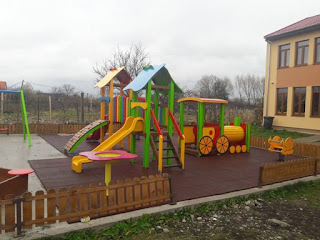Nadszedł koniec naszego projektu przygotowywanego z Rumunią.
Dzieciaki dostały kartki świąteczne oraz mnóstwo serdecznych słów od dzieci z Rumunii.
A oto nasi partnerzy:

Przesłali nam również piękną prezentację o tradycji podczas Świąt Bożego Narodzenia.
In our class there are 13 children from 3 years to 6 years old. There are ten girls and three boys.
This is our school....
And this is our class...
SOME ROMANIAN CUSTOMS
The Star Carol
From Christams until the Epiphany the children go caroling with the star, an old custom that is practised by all Christian nations. This custom is meant to remind people about the star announcing Jesus’s coming into the world and guided the magi on their way.
Sorcova
Belonging to he New Year’s customs, going with “sorcova” represents mainly the children’s joy. They carry a tree budded branch or a sorcova, that is a stick wrapped in flowers made of coloured paper.
Going caroling
Another custom popular among all Romanians is going caroling. Caroling stasts on the 24th of December and can continue 2 or 3 days; people usually go caroling in groups, either consisting in children or adults, old people, girls only, boys only, married couples, according to the ethnographic region.
Plugusorul (Little plough)
It is a Romanian traditional wish made around the New Year, Plugusorul has kept the riualistic scenario of a magical invocation with an agrarian elements. Is is always accompanied by cries, lashes and bells ringing, but the real plough pulled by oxen was in time, replaced with a diminutive plough, easier to be carried, on the sound of ox (wooden tub) that imitates the oxen mooing. Today, the text used in Plugusorul has lost its magical incantation character. Recited in a joyful rhythm, the wish becomes more amd more cheerful, optimistic as it reaches the end.
The goat dance
This custom usually lasts from Christmas until the New Year. The wasks that recall biblical characters in Vicleim are replaced here by the mask of a sole animal, whose name differs according to the region:a stag in Hunedoara; a goat or a turca (ghost with stag head) in Moldova and Ardeal; borita (term coming from bull; il is a man disguised with an animal mask) in southern Transilvania. In Muntenia and Oltenia, the goat is named brezaia (because of the mottled appearance of the mask) andthe custom is practised especially on the New Year’s Eve.
A to my kiedy wysyłaliśmy i otrzymaliśmy karki:



























Brak komentarzy:
Prześlij komentarz